









The periodic musings of a bellmaker... GRB / Gordon R. Barnett











It seems useful [most of all to me!] to review this map of our ship's route as I continue to grok all the parts piled-up into my still muddled memories of this entire piece of travel. As I push to finish blogging about it before we leave on the next trip I wonder idly about the sense & more-so of any sensibility of moving around the planet at our current pace. We have become a little manic in using the time we have left with stamina & health enough to survive into a proper dotage. I'm looking forward to a more creative spell of working & creating visually as well as verbally. I want to draw as well as playing with words. That's my better dream of "retirement"... It will come...
I remember from grade school, the apocryphal story about Robert the Bruce taking a lesson on fighting for the Scottish independence... from a persistent spider who kept patiently rebuilding its web. This sculpture celebrates the laurels of such patience.



So, since they are also close in my photo file, I share a photo from one of our tour bus stops to meet some of those gentle Shetland ponies... but I also enjoyed the herds of sheep as being more useful for their wool, which I would have enjoyed, shopping for the flat hat I'm wanting... if we'd had more time. [Ah... that complaint again about the rushed cruise schedule!]


Such a house seems part of a romantically desolate novel

Mark did indeed get to see the Scottish castles which were his initial request to see, but we'd seen numerous better ones before braving the Fringe Festival crowds below our steep climb up to the walls of Edinburgh Castle on the hot day we were there. Eventually our need for lunch & a beer enticed the the three of us brothers to cool-off in a happy pub upstairs above the street.
As I've been doing, I enjoy sharing bits of functional detail which would be casually overlooked but which captivate my eyes, like this handsome cast concrete balustrade...
Stephen & I woke quite early together deciding to make a little private adventure of the morning as we cruised into & up the fjord into the home port of the Viking line... & of our ship named Saturn...
We went up to the top deck to the Explorer's Lounge...



 |

